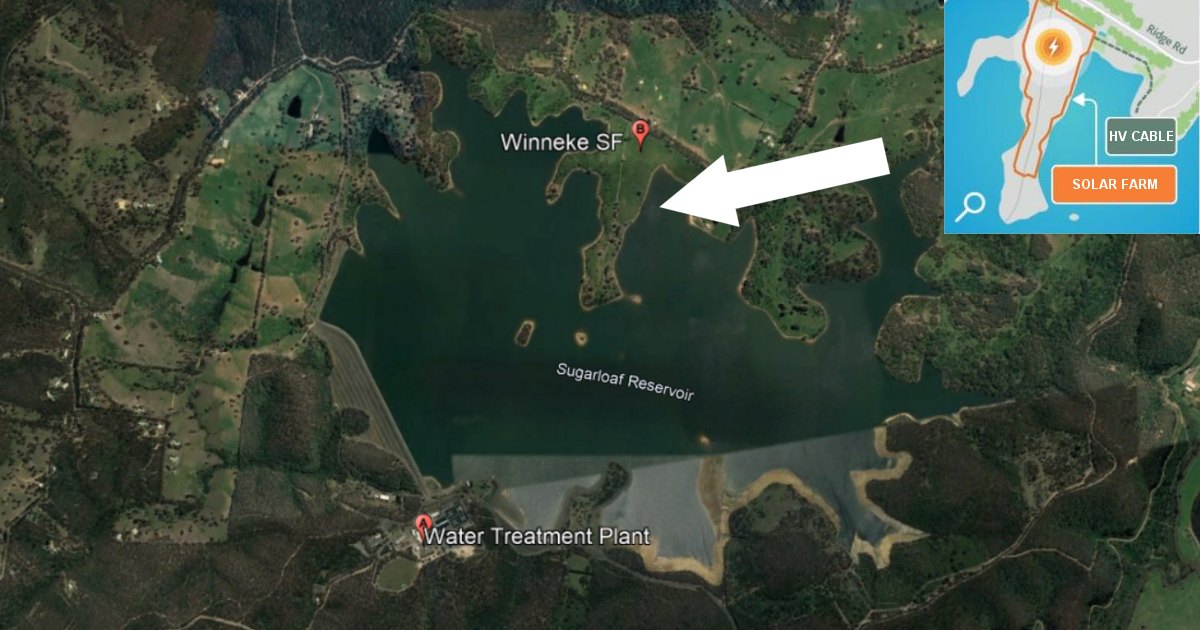
Preparatory works for Melbourne Water’s Winneke Treatment Plant solar farm are about to begin.
Built at Sugarloaf Reservoir in Christmas Hills in 1980, Winneke was the first plant to supply Melbourne with fully treated water; and today it provides around a quarter of Melbourne’s drinking water.
Water treatment and delivery is an energy-intensive affair, as is sewage treatment – the utility also processes more than 90% of the city’s sewage. The Victorian water sector overall represents the single largest contributor to total State Government carbon emissions.
Among actions to reach a goal of halving its emissions by 20251, Melbourne Water is about to have a 9 MW solar farm consisting of approximately 20,000 solar panels covering an area of 10 hectares constructed along the northern shore of Sugarloaf Reservoir.
A 9MW solar farm in that location could be expected to generate approximately 11.7 gigawatt-hours of clean electricity annually; more if the solar panels are installed on trackers. This “behind-the-meter” clean power station will cut the Winneke Treatment Plant’s carbon emissions by up to 12,000 tonnes per year.
Melbourne-based Beon Energy Solutions is building the facility and will make a start on early works very soon – likely next week if it hasn’t already begun. Among this work is the establishing a site office and tree protection zones, temporary and permanent fencing, further site survey work and delivery of construction facilities.
Melbourne Water says the project will involve an expected construction timeframe of 12 months, with the solar farm to be operational by early to mid-2023.
Melbourne Water And Renewable Energy
The Winneke Treatment Plant project is big, but dwarfed by the utility’s 18MW PV project at the Eastern Treatment Plant in Bangholme currently under construction, which will be among the biggest behind-the-meter solar installations in Australia when it is completed.
The first row of solar panels was installed back in September last year. While there has been little news since, Melbourne Water said in September the facility – also being built by Beon Energy Solutions – is expected to be done and dusted by the middle of this year.
These two solar facilities combined are expect to crank out 44.6 gigawatt-hours of solar electricity per year and will build on existing renewables in Melbourne Water’s stable, including 14 mini-hydro power stations generating 60 gigawatt-hours of electricity annually. The utility also captures biogas from sewage treatment that is then used for electricity generation; contributing 80% of the Western Treatment Plant’s and 30% of the Eastern Treatment Plant’s electricity needs.
Melbourne Water’s other recent climate related activities include joining the UN-led Race To Zero campaign in November last year, alongside 12 other Australian water utilities – all of which have pledged to reach net zero emissions by 2050 or earlier. In Melbourne Water’s case, it is investigating the potential to reach net zero by 2030.
Footnotes
- This will reduce reportable greenhouse gas emissions to 204,380 tonnes CO2-e by that year. ↩

 RSS - Posts
RSS - Posts



Speak Your Mind